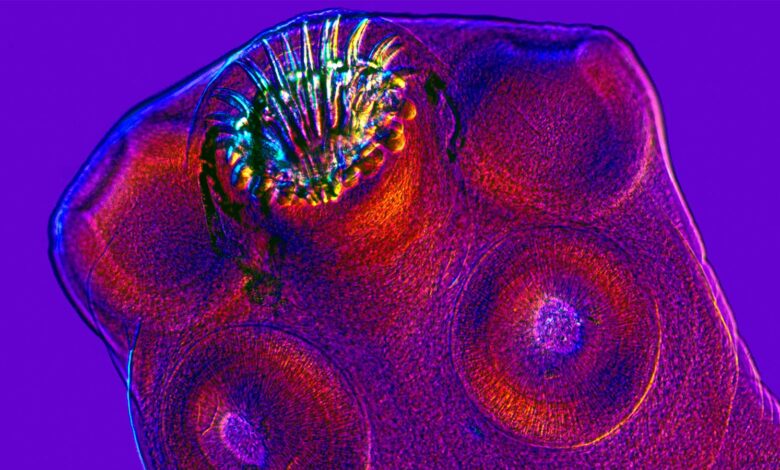Brain Worms Like RFK Jr.’s: Here’s What to Know

—
About 2,000 people in the U.S. are hospitalized with neurocysticercosis each year
by
Judy George
,
Deputy Managing Editor, MedPage Today
May 9, 2024
Did a worm eat part of the brain of presidential candidate Robert F. Kennedy Jr.?
The New York Times reported that, in a 2012 deposition, Kennedy said he had CT abnormalities and cognitive problems due to “a worm that got into my brain and ate a portion of it and then died.” Kennedy also has said he had brain fog due to mercury poisoning at one time, along with atrial fibrillation.
In a YouTube interview this week, Kennedy said the “brain worm” was most likely neurocysticercosis, a brain infection caused by a tapeworm.
“With the information we have thus far, it appears most likely that Kennedy’s condition was consistent with an infection by the pork tapeworm Taenia solium,” Simon Groen, PhD, of the University of California Riverside, said in an email to MedPage Today. “It appears Kennedy traveled extensively in Africa, South America, and Asia in the past, and these regions have a much higher prevalence of infections than the U.S.”
Neurocysticercosis cysts don’t “eat” brain, said Philip Budge, MD, PhD, of Washington University School of Medicine in St. Louis. “The parasite larvae reach the brain via the circulatory system, then produce a cyst that displaces the surrounding tissues.”
“The consequences can be severe if the cyst forms in a very sensitive location — such in the ventricles or blocking a cerebrospinal fluid outflow tract — but a live cyst doesn’t actually destroy any surrounding tissue,” Budge told MedPage Today. “However, when a cyst dies, the immune response to the dying cyst can cause swelling and inflammation, which may damage tissue or cause seizures.”
Depending on which part of the brain the worms encyst in, the subsequent inflammation and edema also can lead to “cognitive problems and personality changes, and even blindness, comas, and paralysis,” Groen said.
Brain cysts from worm infections are a leading cause of seizures worldwide, according to the World Health Organization. The CDC estimates that about 2,000 people in the U.S. are hospitalized with neurocysticercosis each year. Seizure and headache are the most common symptoms.
In 2017, the Infectious Diseases Society of America and the American Society of Tropical Medicine and Hygiene issued comprehensive clinical practice guidelines on diagnosing and treating neurocysticercosis.
Forms of neurocysticercosis can range from single cysts that may be relatively harmless to blockages that cause pressure and fluid on the brain, noted guideline author A. Clinton White, MD, of the University of Texas Medical Branch in Galveston. Neurocysticercosis “can even be asymptomatic,” he told MedPage Today.
Clinical practice guidelines call for both CT and MRI to determine treatment and recommend ordering an enzyme-linked immunotransfer blot (EITB) to confirm the diagnosis, rather than a less sensitive enzyme-linked immunosorbent assay (ELISA).
Steroid and anti-parasitic medications can help treat a single live brain cyst, but patients with multiple viable cysts should be treated with a combination of anti-parasitics. If a cyst blocks a ventricle, it should be removed by neuroendoscopy. Patients who develop hydrocephalus may require a shunt to drain excess fluid, and those with seizures can benefit from anti-epileptic drugs.
“There may be mild cognitive problems with neurocysticercosis, especially in those who develop recurrent seizures,” White noted.
Neurocysticercosis is a common cause of neurologic disease in areas where pigs are raised and where there is poor human hygiene, White said. “It causes about a third of seizures in those areas.” Almost all the hospitalized people with neurocysticercosis in the U.S. carry it from another country; it is rarely acquired domestically, he added.
“One reason this is rare in the United States is that we do a pretty good job of preventing fecal-oral contamination in our food and water supply,” Budge said. “The other reason is we don’t have many tapeworm carriers, because the disease has been essentially eliminated from domestic swine herds.”
The parasite that causes cysticercosis, T. solium, is a tapeworm that is normally passed back and forth between pigs and people, he pointed out.
“In people, it usually lives as a tapeworm in the gut of an infected person. The tapeworm eggs are spread to pigs when they ingest the food contaminated with human fecal material. In the pig, the eggs hatch into larvae and form cysts, and people can get the tapeworm by eating undercooked pork,” Budge said.
“But for a person to get a cyst, they have to ingest the eggs, which are shed in the feces of someone carrying the tapeworm,” he added. “So, to prevent it, avoid eating contaminated food, especially when traveling.”
-
Judy George covers neurology and neuroscience news for MedPage Today, writing about brain aging, Alzheimer’s, dementia, MS, rare diseases, epilepsy, autism, headache, stroke, Parkinson’s, ALS, concussion, CTE, sleep, pain, and more. Follow


